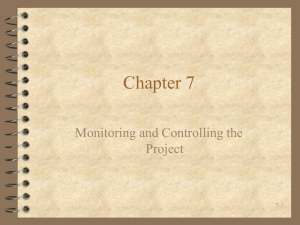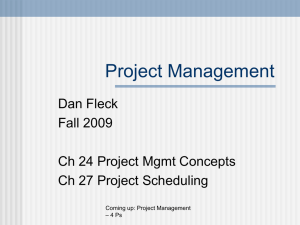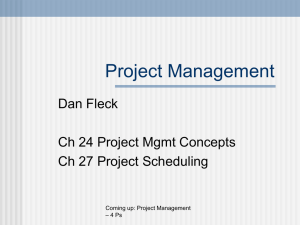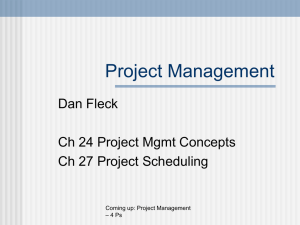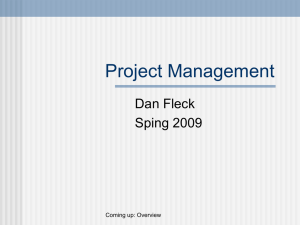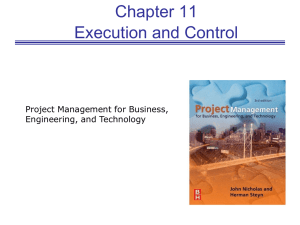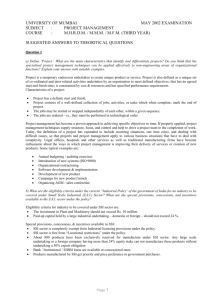Project Management
advertisement
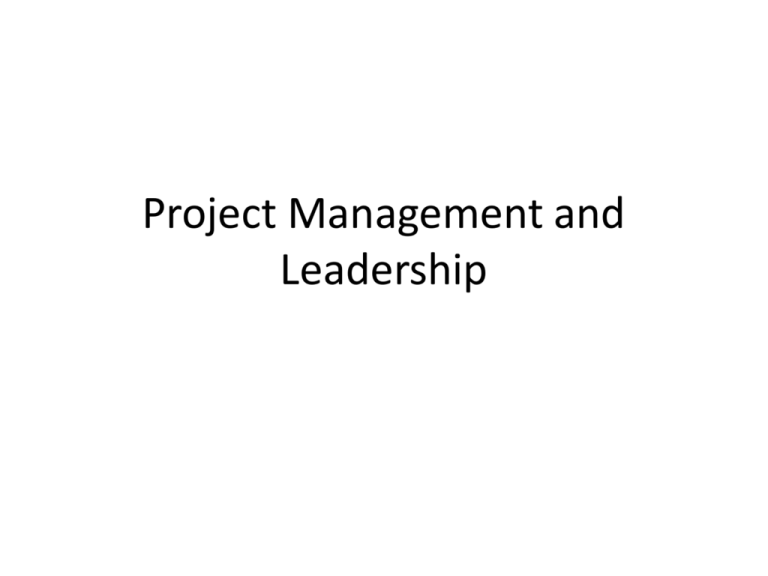
Project Management and
Leadership
Why care about management?
• 10% of projects were “successful” between
1998 and 2004
Management vs Leadership
• Management is using tools and techniques
• Leadership is inspiring people to the right
thing
• Can these succeed?
– Poor management with good leadership?
– Poor leadership with good management?
Leadership: motivating people
• Use monetary rewards cautiously
• Intrinsic rewards
– Recognition
– Achievement
– The work itself
– Responsibility
– Advancement
– Novelty
Define success and failure
Management
•
•
•
•
Empirical project planning and scheduling
Risk management
Metrics-based management against targets
Defect tracking
Scheduling
• Must begin immediately, even with limited
information
• A list of tasks
– Start dates
– Duration
– Assigned resources (people)
– Predecessors and successors
• Getting buy-in from the team
– Use historical data and increments
Example schedule in OpenProj
Scheduling terms
• Critical path (in red)
– Any delay along these tasks result in a delayed
project
– Can be found manually, but tools often do this for
you
• Slack
– The amount of time a task can be delayed without
affecting the schedule
– No slack along the critical path
More scheduling terms
• Resource leveling
– Making sure that no person is working above
100% capacity at any point in time
– Happens when multiple tasks are scheduled for
the same person
– Break up a task into smaller, sequential tasks with
a dependency between them (i.e. take more
time); tools can automatically do this for you
– Or, manually add additional resources to the task
so no one is working over 100%
Scheduling for Agile projects
• Do we need to plan, even if we’re only looking
a month ahead?
• Sure!
– Sprint burndown charts
– Release burndown charts
Story Points Remaining
Sprint burndown chart
Day
• Exercise: Are we ahead of schedule, or behind?
Story Points Remaining
Sprint burndown chart
Day
• Answer: behind.
• Exercise: But how would you tell if this is
something to worry about or not?
Story Points Remaining
Sprint burndown chart
Day
• Answer: Look at previous burndown charts –
maybe things are slower the first couple of days,
but then pick up!
Earned Value Management
• How much work you planned to have accomplished
by now (in dollars or hours) called the Planned Value
• How much you have actually spent by now (in dollars
or hours), called Actual Cost
• The value, in terms of your baseline budget, of the
work accomplished by now (in dollars or hours),
called the Earned Value!
• Budgeted (cost) at completion (BAC) - The sum of all
the PVs
Idea is to link schedule and cost together to monitor
both in the same “units” of value
Earned Value Management Example
• We’ve budgeted $200 to buy, setup, network,
and test a new system
– Our PVs are $50 to buy, $75 to setup, $50 to
network, and $25 to test
– Our BAC is therefore $200
• Right now, we have spent $60 (AC) and have
completed the buying phase (EV of $50)
– Are we on schedule?
– Are we on budget?
EVM Example
Line 2
is at 16, blue
bar ends at 14
Line is at 6
PLANNED VALUE (Budgeted cost of the work scheduled)
= 18 + 10 + 16 + 6 = $50
EARNED VALUE (Budgeted cost of the work performed)
= 18 + 8 + 14 + 0 = $40
ACTUAL COST (of the work performed) = $45 (Data from Acct. System)
Therefore:
Schedule Variance = 40 - 50 = -$10
Schedule Performance Index = 40 / 50 = 0.8
Scope Creep
• The scope of your project is the work you
originally planned to do
• Scope creep is when more tasks are added,
without adding more resources
– Happens often. Exercise: What are some reasons
of needing additional tasks?
– Exercise: What is the cause of scope creep (not
adding more resources, otherwise we just
consider it scope change)?
Scope Creep
• Answer: What are some reasons of needing
additional tasks?
–
–
–
–
competitor has some new feature
customer forgot something
received more money
misunderstood original requirements
• Answer: What is the cause of scope creep (not
adding more resources, otherwise we just
consider it scope change)?
– adding more requirements without having a manager
that will insist on more resources to compensate
Avoiding scope creep
• Joint Application Development
– between management and customer
• Formal change approval
– forces compensation for doing more work
• Defer additional requirements for future
versions
– “What a great idea! Let’s do it in version 2! By the
way, I’ll need $XXXX for version 2…” job
security!
Management
• Empirical project planning and scheduling
• Risk management
– Another lecture
• Metrics-based management against targets
– Another lecture
• Defect tracking
– Another lecture
Quiz review
• What is the difference between management and
leadership?
• What is true of any task on the critical path?
• How is scope creep different than adding more
requirements/features?
• What is Planned Value?
• What is Earned Value?
• What is Actual Cost?
• How do we know when we are over/under
budget/time in Earned Value Management?
– create formulas for these four cases using PV, EV, and AC
In-class exercises
• Give an example of a good intrinsic reward at
work
• Create a schedule for students next semester for
the following CS321 assignments:
– project assignments {use cases, class diagram,
swimlane diagram, sequence diagram, coding, testing}
– essay outline, essay draft
– studying for final
– consider duration, dependencies, and opportunity for
parallelization
• Due next class
